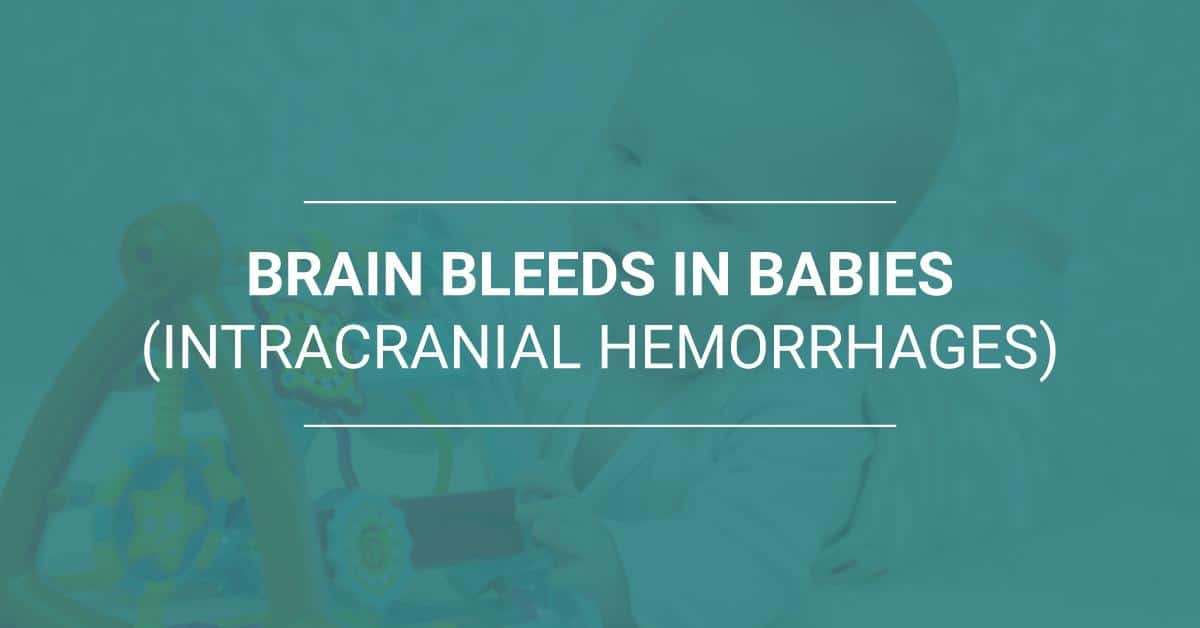
A brain bleed – also known as an intracranial hemorrhage – occurs within the brain or between the brain and the skull. When this occurs, it can damage the brain tissue and cause long-term effects. In some cases, a brain bleed may even be fatal.
While not all brain bleeds are preventable, there are situations where brain bleeds are caused by medical negligence. This may include a failure to appropriately monitor a fetus, to intervene in an emergency during labour and delivery, or even trauma during the birth itself. If your child suffered a brain bleed as a result of medical negligence, you may be eligible for financial compensation.
Signs and Symptoms of Brain Bleeds in Babies
There are a number of signs of brain bleeds in a newborn. These symptoms may include:
- Seizures
- High-pitched cry
- Decreased reflexes
- Pauses in breathing, or apnea
- Pale or blue coloring (cyanosis)
- Weak sucking
- Lethargy or coma
- Slow heart rate (bradycardia)
- Swelling or bulging of the soft spots on the baby’s head
- Decreased muscle tone
- Low red blood cell count
- Abnormal eye movement
These signs may not be present immediately after birth and may be mistaken for other health issues. It is critical that medical professionals closely examine your baby to diagnose a potential brain bleed. Diagnosis typically involves a physical exam along with an ultrasound of the brain/head. Treatment for an intracranial hemorrhage may include fluids, oxygen, and surgery to drain the fluid and stabilize their condition.
Long Term Effects of a Brain Bleed on a Child
There are four types or grades of brain bleeds:
- Grade 1. Bleeding occurs just in a small area of the ventricles.
- Grade 2. Bleeding also occurs inside the ventricles.
- Grade 3. Ventricles are enlarged by the blood.
- Grade 4. Bleeding occurs in the brain tissues around the ventricles.
Grades 3 and 4 are the most serious and often result in long-term effects for the baby.
The effects of a brain bleed depend in part on how severe the hemorrhage was. Babies with a Grade 1 or grade 2 intracranial hemorrhage may not have any long-term effects. However, newborns who are diagnosed with a Grade 3 or 4 brain bleed may experience significant effects.
Complications of a brain bleed may include hydrocephalus (too much cerebrospinal fluid in the brain), long-term brain injury, seizures, problems with learning, speech or movement, developmental problems, and even death. Studies have found that children who experienced a brain bleed as an infant have higher rates of cerebral palsy and hearing impairment, along with lower IQs, fewer daily living skills, and lower test scores at school.
Causes of Intracranial Hemorrhages/Brain Bleeds
A brain bleed, or intracranial hemorrhage, is a type of birth injury. For newborns, it involves bleeding into the ventricles (fluid-filled areas) of the brain. It is most commonly associated with premature birth, and in particular, infants who are born more than 10 weeks early.
Brain bleeds can have a number of causes, including asphyxia (oxygen deprivation at or near the time of birth) and birth trauma, such as using forceps or vacuum extractors or improper delivery techniques. These types of complications often arise from medical negligence.
Risk factors for brain bleeds include:
- Macrosomia, which occurs when the fetus is larger than average for gestational age
- Abnormal fetal presentation, such as breech, face, or brow presentation
- Trauma-related to prolonged labour
- Unstable blood pressure
- Cephalopelvic disproportion (CPD), when the fetal head is unusually large and/or the mother’s pelvis is unusually small
- Blood disorders, including vitamin K deficiency
- Hypoxic-ischemic encephalopathy (HIE), which is a neonatal brain injury that occurs when a baby has decreased oxygen and blood flow during labour and delivery
If a baby has any risk factors for intracranial hemorrhage, including being more than 10 weeks premature, then medical professionals must monitor the baby for signs of fetal distress and potentially perform a cesarean section (c-section).
Doctors should also work to prevent premature birth whenever possible, as premature babies typically have underdeveloped blood vessels that are more susceptible to brain bleeds.
Caring for a Baby with a Brain Bleed
Bleeding in the brain can damage brain tissue, and may lead to brain swelling or compression. Caring for a child with a brain bleed can be difficult. An intracranial hemorrhage can affect children differently, so parents and caregivers may have to adapt to meet their child’s needs.
Many children who had a brain bleed as an infant will require regular care from doctors. For example, if a child is diagnosed with epilepsy as a result of an intracranial hemorrhage, then they may need to see a neurologist for treatment for their seizures.
Because brain bleeds can cause problems with learning, speech, and/or movement, other specialist care might be required. Many children with brain bleeds require speech, physical or occupational therapy to address any developmental delays. Kids with behavioral issues may also need other types of therapy.
For parents, caring for a child with a brain bleed can be incredibly expensive. Their child may also require care throughout their life. For this reason, it is important to consult with a skilled birth injury lawyer who can advise you of your rights and options for pursuing a legal claim.
Brain Bleeds in Babies Caused By Medical Negligence
In some cases, brain bleeds in newborns are not preventable. In other situations, however, a brain bleed could have been prevented by a conscientious medical professional. If a brain bleed or intracranial hemorrhage was caused by medical negligence, then the baby’s parents might be eligible for financial compensation.
A brain bleed caused by medical negligence should be considered by a team of experienced birth injury lawyers. Contact BILA today at 1-800-300-BILA or via our online contact form for more information about a potential legal claim and to discuss your child’s birth injury case.

John McKiggan, QC has represented clients in pediatric and adult injury claims that have resulted in multi-million dollar awards. In recognition of his accomplishments, John has been honoured by his peers, who elected him president of the Atlantic Provinces Trial Lawyers Association. He has also been named Queen’s Counsel, a designation recognizing exceptional professional merit. John has been selected for inclusion in the Best Lawyers in Canada in the field of personal injury law, he is listed in the Canadian Legal Lexpert Directory and has been named a local litigation star by Benchmark Litigation Canada.
